Neuroplasticity is the brain’s amazing ability to change and adapt. It has changed how we see learning and getting better at skills. Recent studies show that the brain changes a lot because of learning and growing throughout our lives1. This discovery shows us new ways to learn faster and improve our thinking.
Using neuroplasticity, we can make our brains better at learning new skills quickly. Tools like MRI and fMRI let scientists study how the brain changes when we learn1. These tools show us how our experiences shape our brain’s ability to change1.
Learning strategies based on neuroplasticity help us make new brain connections and adapt to challenges. Whether it’s learning a new language, playing a musical instrument, or getting better at complex thinking, knowing about brain plasticity can speed up your learning. Changes in the brain happen faster than we thought, helping us learn new skills2.
🎯 Ready to Transform Your Results?
Get the complete system that hundreds have used to achieve breakthrough results.
Get the Book for $7Key Takeaways:
- Neuroplasticity involves robust structural and functional changes in the brain induced by learning and experience.
- Neuroimaging techniques like MRI and fMRI enable the examination of neural changes related to skill acquisition.
- Experience-expectant and experience-dependent mechanisms shape neural plasticity.
- Plastic changes in brain architecture occur over shorter time periods than previously thought.
- Harnessing neuroplasticity principles can accelerate learning and cognitive enhancement.
Understanding the Fundamentals of Neuroplasticity
To understand how neuroplasticity-based learning works, we need to know the basics. This idea that our brains can change and adapt has been studied a lot, especially in the 1990s3. It shows that our brain abilities can grow and change as we live.
Defining Neuroplasticity and Its Implications for Learning
Neuroplasticity means our brain can change by making new connections. This happens because of our experiences and the things we do. It involves making new neurons, changing how neurons connect, and adapting based on what we learn4.
This idea changes how we see learning. It tells us our brains can change and grow with our experiences. Students who think their intelligence can change do better in school and stay motivated3.
The History and Evolution of Neuroplasticity Research
People first thought about neuroplasticity in the mid-1800s. But it wasn’t until the 1990s that scientists really looked into it3. They found out how the brain changes after injuries or when senses are lost. Now, we know it’s a key part of how our brains work, helping us learn and get better at things.
| Neuroplasticity Principle | Description | Implications for Learning |
|---|---|---|
| “Use It or Lose It” | Neural circuits not actively engaged in task performance for an extended period of time degrade. | Consistent practice and engagement are essential to maintain and strengthen neural connections. |
| “Use It and Improve It” | Specific brain functions can be enhanced through targeted training. | Engaging in activities that challenge specific cognitive or motor skills can lead to improved performance. |
| “Specificity” | Training activities must be tailored to produce desired results in specific neural circuits. | Learning experiences should be designed to target the specific skills or knowledge areas we wish to develop. |
| “Repetition Matters” | Sufficient repetition is necessary to induce lasting plasticity. | Consistent practice and rehearsal are crucial for embedding new knowledge and skills in neural networks. |
As we learn more about neuroplasticity, we see its big role in learning and getting better at things. Using ideas like “Use It and Improve It” and “Repetition Matters” helps us make learning better5. This way, our brains can adapt and grow faster, helping us do better in many areas.
The Brain’s Remarkable Ability to Adapt and Change
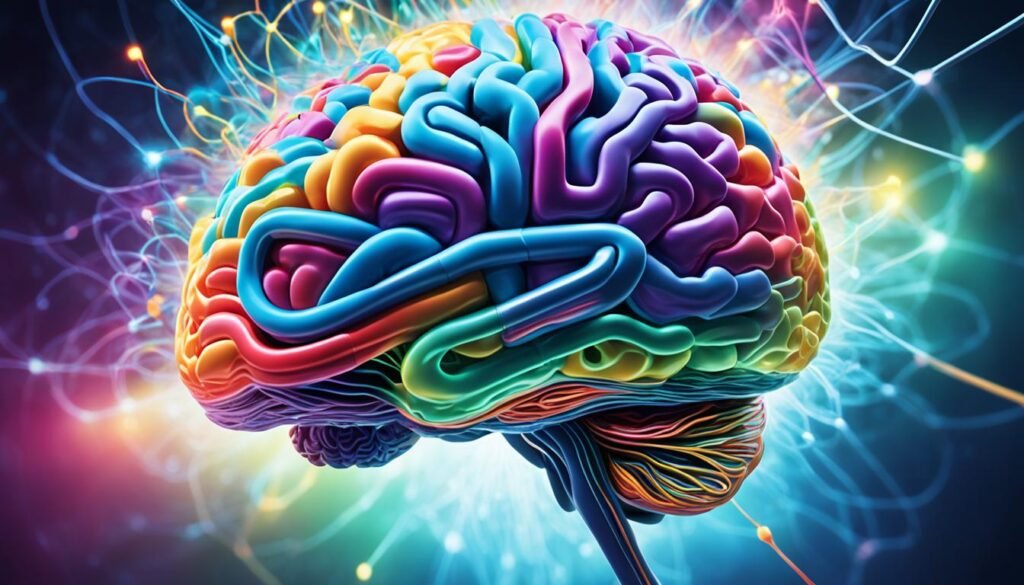
The human brain is amazing because it changes and grows throughout our lives. It’s full of Neural Adaptability. This means it can change itself through something called neuroplasticity6. This ability lets us learn, grow, and adapt to new things, making Lifelong Learning possible.
When we try new things, like learning a new skill, our brain changes. This can be seen in how it changes when we learn a new language or play a musical instrument6. These changes help us adapt and adjust to new situations better6.
Many things affect how our brain changes, like our genes, our environment, and our experiences6. Knowing this helps us use our brain’s power to improve our mental health. Things like therapy and mindfulness can make our brains more flexible and improve our mental health6.
The human brain has about 100 billion neurons7. At birth, each neuron has about 2,500 connections, growing to 15,000 by age three7. As we get older, we lose some connections, but still have a lot of them7.
To keep our brains flexible, we should do things that help it stay adaptable. The U.S. Department of Health suggests doing at least 150 minutes of exercise a week7. This can help keep our brains healthy and flexible.
Exercise isn’t the only way to keep our brains sharp. Doing things that challenge our minds, like puzzles or games, can also help7. By keeping our brains active, we can keep learning and adapting as we age.
| Neuroplasticity-Based Therapy | Targeted Condition | Outcomes |
|---|---|---|
| Constraint-Induced Movement Therapy | Chronic Hemiparesis in Stroke Survivors | Significant improvements in arm function and changes in brain activity patterns8 |
| Targeted Bimodal Auditory-Somatosensory Stimulation | Tinnitus | Significant reductions in tinnitus-related distress and improvements in quality of life8 |
| Transcranial Magnetic Stimulation (TMS) | Treatment-Resistant Depression | Significant reductions in depressive symptoms, with response rates of up to 50%8 |
| Cognitive and Behavioral Interventions | Autism Spectrum Disorder (ASD) | Changes in brain structure and function, improvements in social communication and adaptive behavior8 |
Therapies based on neuroplasticity can really help with many health issues8. They show how powerful it is to use our brain’s ability to change. By using this power, we can grow and learn new things throughout our lives.
Harnessing Neuroplasticity for Accelerated Learning
To make the most of neuroplasticity for faster learning, we need a great learning space. This space helps the brain adapt and change naturally. Over the last 20 years, we’ve learned a lot about how the brain changes and how we can use this for learning9.
Creating an Optimal Learning Environment
A top learning space challenges the brain and helps it learn new things. Doing different activities and training in various ways makes the brain stronger for fast learning10. It’s also key to focus on healthy living, like getting enough sleep, eating right, and exercising. These habits help the brain work better10.
Engaging Multiple Senses to Enhance Neural Connections
Learning with all your senses at once is great for fast learning. It makes learning richer and helps you remember better. Studies show the brain can change to help you recover from injuries, showing how important using all your senses is9.
Using all your senses in learning makes it fun and builds strong brain connections.
The Power of Repetition and Practice in Skill Acquisition
Repeating things and practicing is key for fast learning. It makes brain paths stronger and helps memories stick. The more you do a skill or recall a memory, the easier it gets later on. This changing of the brain helps by making new connections and even creating new brain cells10.
| Learning Strategy | Benefits |
|---|---|
| Spaced Repetition | Helps you remember things longer by reviewing them at set times |
| Deliberate Practice | Improves specific skills by focusing on them |
| Interleaved Practice | Mixes skills or topics to make you more adaptable and solve problems better |
Using these strategies in our learning can make us learn faster and remember better. The brain can always change and make new connections. With the right approach, we can unlock its full potential for learning quickly10.
The Role of Attention and Focus in Neuroplasticity
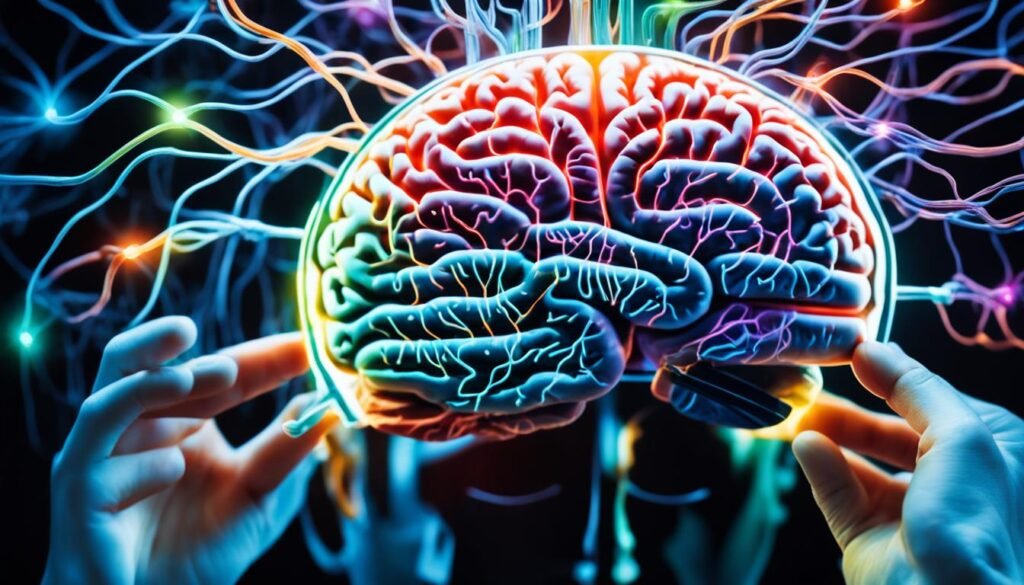
Attention and focus are key to using neuroplasticity for better learning and skills. By focusing on tasks, we make our brains adapt and change. This helps create new connections and make old ones stronger11. It’s vital for learning new things fast.
Studies on mindfulness meditation show more gray matter in areas linked to attention and thinking11. Training to improve memory boosts activity in areas that control attention11. These facts highlight how important attention and focus are for learning.
Techniques for Improving Attention and Concentration
Here are ways to improve focus:
- Deep breathing exercises: Deep breathing makes us more alert by releasing a hormone that helps focus.
- Visual focus: Looking at a point for a bit before a task starts gets the brain ready to focus.
- Meditation and mindfulness practices: Regular meditation improves focus, attention, and thinking skills.
Minimizing Distractions to Maximize Learning Potential
Today, distractions are everywhere and can make it hard to focus and learn. To learn better, we should reduce distractions by:
- Turning off phones and devices during learning
- Using the internet and social media less while learning
- Creating a place just for learning
- Doing one task at a time to avoid losing focus
Using these tips helps us focus better and learn more efficiently. People who kept learning and stayed mentally active in the Mayo Clinic Study of Aging did better in thinking skills. They started showing signs of cognitive decline about 8.7 years later than others12. This shows how important it is to keep learning and focusing to keep our minds sharp12.
“Attention is the key to learning, and by harnessing the power of focus, we can unlock the incredible potential of neuroplasticity to transform our minds and lives.”
Understanding how attention and focus work with neuroplasticity helps us learn faster and think better. By reducing distractions and focusing on learning, we can grow personally and professionally. Staying focused is key to keeping our minds healthy as we age.
Embracing Challenges and Mistakes as Opportunities for Growth
Growth often comes from the challenges we face and the mistakes we make. People with a growth mindset see challenges as chances to learn and grow13. They keep going through tough times and see failures as ways to learn and get better.
Our brains can change and adapt, thanks to neuroplasticity13. When we face challenges or make mistakes, our brains make new connections and strengthen old ones. This helps us learn better14. Having a growth mindset means we focus on learning and getting better over time, not just on being good at something14.
Challenges help us grow by making us stronger and more capable14. By doing things that push us out of our comfort zone, we make our brains more flexible and improve our skills. James Clear, from “Atomic Habits,” says in his article on neuroplasticity and behavior change, “The key to changing your habits is to focus on creating a new identity first. Your current behaviors are simply a reflection of your current identity.”
Learning from mistakes is key for those who grow and improve. Instead of seeing failures as a sign of weakness, they see them as chances to get better14. By looking at our mistakes and changing how we do things, we keep getting better and making our brains stronger.
“Success is not final, failure is not fatal: it is the courage to continue that counts.” – Winston Churchill
To make the most of challenges and mistakes, try these tips:
- See challenges as chances to learn and grow
- Celebrate your small wins and the effort you put in
- Use failures as feedback to improve your approach
- Love learning and be open to trying new things
By facing challenges and learning from mistakes, we use neuroplasticity to grow faster. As we keep adapting and changing, we reach our full potential and achieve our goals.
The Importance of Sleep and Rest in the Learning Process

Exploring neuroplasticity-based learning shows how vital sleep and rest are. Learning changes our brains, but sleep and deep rest make these changes stick15.
Researchers have long talked about sleep’s role in learning. In 1971, Rechtschaffen A. pointed out sleep’s importance for learning15. Later, in 2008, Cirelli and Tononi showed how sleep helps the brain learn and remember15. Sleep is key for keeping memories sharp and brain connections strong15.
How Sleep Consolidates Memories and Strengthens Neural Pathways
At night, our brains work to make memories stronger and neural paths more solid. Studies show sleep boosts learning, especially for motor skills after a stroke16. Sleep affects brain genes in unique ways, showing its impact on learning15.
Not sleeping enough hurts our thinking and learning. Durmer and Dinges in 2005 found sleep loss affects our brain15. Walker and McCoy in 2008 and 2011 also showed how too little sleep harms our thinking15.
Incorporating Restorative Practices to Optimize Learning
To make the most of learning, we should focus on rest as much as activity. Getting enough sleep, at least 80%, helps learning a lot17. Adding short naps or self-hypnosis after learning boosts learning even more.
Our lifestyle, like eating well and exercising, also affects learning17. Exercise improves our thinking and moving, and helps our brains stay flexible17. Mixing rest with a healthy life makes learning better.
As I learn more about sleep, rest, and learning, I see how powerful our brains are. By focusing on rest and understanding memory, we can use our brains fully. This speeds up our learning.
Neuroplasticity-Based Learning Strategies for Different Skill Sets
Our brains can change and adapt, a process called neuroplasticity. This ability helps us learn new skills. By using neuroplasticity, we can learn faster and better in areas like language, motor skills, and thinking.
Language Acquisition and Brain Plasticity
Learning a new language shows how our brains change. Babies can hear sounds from any language early on. But as they grow, they focus more on their own language, losing the ability to hear other languages clearly18.
To improve language learning, make lessons fun and engaging. Use games, movement, and real-life examples. Short lessons with breaks work well too1920.
Enhancing Motor Skills Through Neuroplasticity Principles
Our brains change as we practice new movements. This helps us get better at sports or dance. Moving while learning keeps students focused and awake19.
For better motor skills, encourage trying new things and learning from mistakes. Group activities help students share and understand better19. Good sleep helps our brains work better for these skills20.
Applying Neuroplasticity to Cognitive Skill Development
Our thinking skills, like solving problems or remembering things, get better with neuroplasticity. Doing fun activities and challenging tasks grows our brain cells19. Using different teaching methods helps us remember better19.
Keeping a good mood helps students learn more. Short naps or rest after learning boosts their thinking skills20.
| Skill Set | Key Neuroplasticity Strategies |
|---|---|
| Language Acquisition | – Immersive learning environment – Engaging multiple senses – Repetition and practice – Shorter learning sessions spaced apart |
| Motor Skill Development | – Movement-based learning – Positive and supportive environment – Experimentation and productive failure – Quality sleep for neural rewiring |
| Cognitive Skill Improvement | – Mentally stimulating activities – Varied modes of lesson delivery – Maintaining a positive emotional state – Rest and recovery periods |
Using neuroplasticity in learning helps us get better at language, movement, and thinking. By applying brain-based learning and creating the right learning spaces, we can achieve great things.
The Impact of Age on Neuroplasticity and Learning
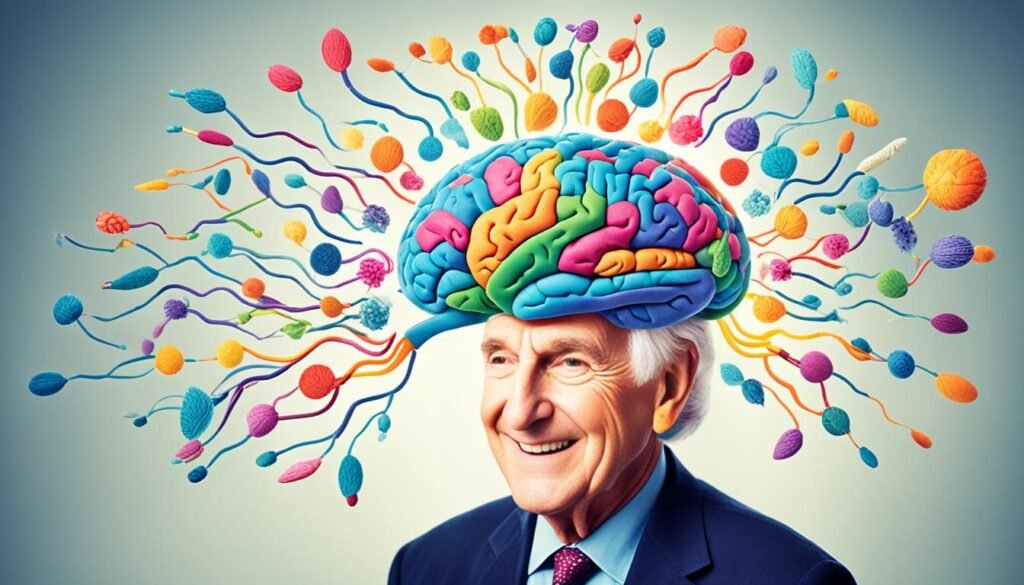
Exploring age-related neuroplasticity shows our brain’s ability to change lasts a lifetime. While early development is key for brain flexibility, research now shows it continues into adulthood and beyond21.
Studies reveal that young and older brains adapt similarly when learning new tasks22. This means, no matter the age, learning new skills changes the brain in ways that help with task performance22.
Random practice schedules can lead to better skill retention in both young and older adults22. This shows older people can handle complex practice and keep skills over time, just like the young22.
Training also changes brain chemicals in young and older people during tasks22. Older adults saw a bigger drop in a brain chemical that helps with learning, showing they can learn and remember better22.
The neural landscape differs between the immature and adult brain, with the mature system having a broader repertoire of previous experiences to draw upon when encountering new information.
New skills can be learned at any age, but older people might take longer22. Still, staying mentally active and open to learning keeps the brain flexible and sharp, even with age22.
Neuroplasticity helps the brain adapt and recover, which can slow down age-related decline21. The brain can change by making new connections and rewiring old ones, even after injuries like stroke21.
| Factor | Impact on Brain Health |
|---|---|
| Exercise | Enhances neuroplasticity and cognitive function |
| Diet | Supports brain health and plasticity |
| Socialization | Promotes cognitive engagement and neural connectivity |
| Stress Management | Reduces negative impact on brain function and plasticity |
| Sleep | Facilitates memory consolidation and brain rejuvenation |
| Cognitive Stimulation | Challenges the brain, promoting neuroplasticity and resilience |
Good brain health comes from many things like lifestyle, genes, and brain chemicals21. By living a brain-friendly life, people of all ages can use neuroplasticity to keep their minds sharp and resilient21.
In conclusion, age affects neuroplasticity, but it’s never too late to start learning and improving your brain. By facing challenges, staying mentally active, and living a healthy lifestyle, we can keep growing and thriving at any age.
Neuroplasticity and the Growth Mindset
Having a growth mindset helps us use neuroplasticity in learning. We learn that our intelligence and skills can grow with hard work and effort23. This idea makes us more motivated, improves our performance, and boosts our grades23.
Cultivating a Growth Mindset to Promote Lifelong Learning
For lifelong learning, a growth mindset is key. We learn that learning makes new or stronger brain connections23. This lets us keep learning and growing at any age. Even after 25, we can learn new skills by focusing and paying attention24.
To grow, we must face challenges and see mistakes as chances to learn. Mistakes help our brain adjust and learn better24. Seeing setbacks as steps to success keeps us motivated and keeps us going.
Overcoming Limiting Beliefs and Embracing Neuroplasticity
Limiting beliefs can stop us from learning and growing. Many think intelligence is set by genes or early life. But learning how the brain works can change this and help us grow through study23.
By using neuroplasticity and a growth mindset, we can beat these beliefs and reach our full potential. Doing activities again, remembering things, and reviewing material makes our brain connections stronger2324. This strengthens our skills and abilities over time.
“The passion for stretching yourself and sticking to it, even (or especially) when it’s not going well, is the hallmark of the growth mindset.” – Carol S. Dweck
With a growth mindset and neuroplasticity, we can change how we learn and grow. We can move past fixed beliefs and explore endless possibilities. Our potential is only limited by how hard we try.
Neuroplasticity-Based Learning in Educational Settings
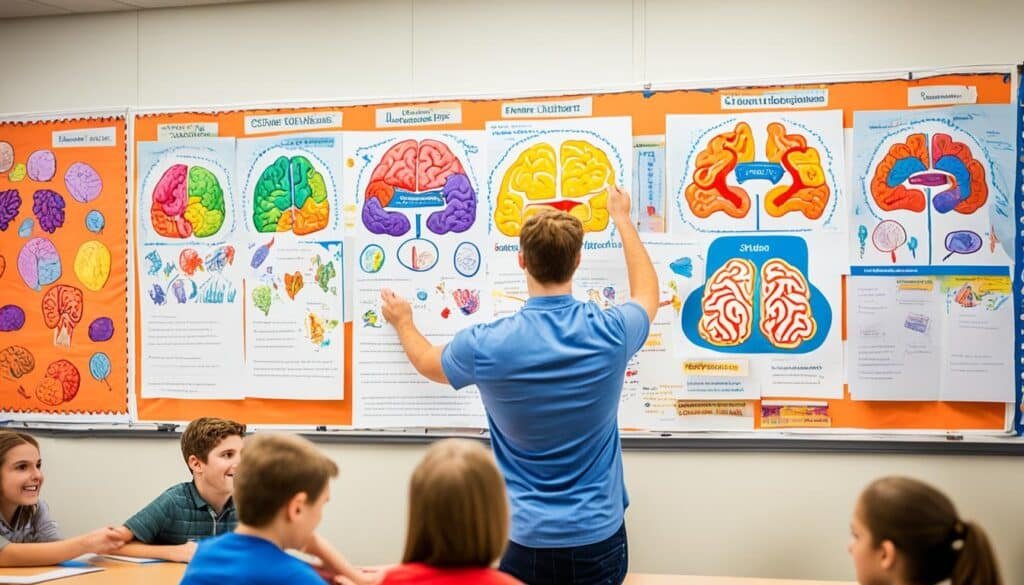
As an educator, I believe that using neuroplasticity in the classroom changes how we teach and learn. It shows us how the brain can change and adapt. This knowledge helps us make better learning environments that help students grow and do well.
Studies show that differences in learning abilities and achievements come from many things. These include things like where they live and what they experience25.
One way to use neuroplasticity is through active learning. When students do hands-on activities, talk about what they learn, and solve problems, they make stronger brain connections. This matches the fact that our brains have billions of neurons that change with what we learn26.
Feedback is also key in neuroplasticity-based learning. Good feedback helps students learn better and think they can grow. Research says how students see their intelligence affects their success, and believing in growth helps them do better, even when they face tough times25.
“The brain is remarkably plastic, continually altering its structure with each new experience, thought and behavior.” – Dr. Dawson Church
Creating a supportive classroom is important too. When students feel safe and valued, they’re more likely to try new things and keep going when it’s hard. This kind of classroom helps students become resilient and adaptable for life. Repetition and focus are key to making brain connections stronger26.
- Encourage active learning through hands-on activities and problem-solving
- Provide frequent and constructive feedback to guide students toward efficient learning strategies
- Foster a supportive and inclusive classroom culture that promotes risk-taking and resilience
- Incorporate multi-sensory learning experiences to engage different areas of the brain
- Teach students about neuroplasticity and the growth mindset to empower them as learners
By using neuroplasticity in teaching, we help students become lifelong learners. They’ll face challenges, keep going when things get tough, and keep growing their knowledge and skills. As teachers, we should keep up with the latest in educational neuroscience to help every student learn and grow.
The Future of Neuroplasticity Research and Its Applications
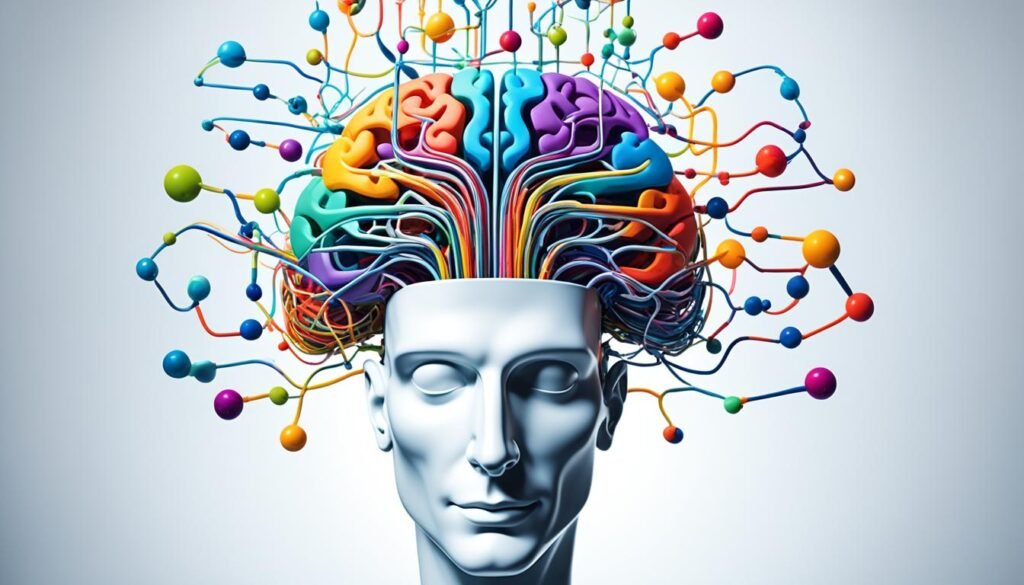
Our understanding of how the brain changes and adapts is growing fast. This growth means big things for how we learn, get new skills, and overcome challenges. Recently, a workshop brought together top scientists to explore how neuroplasticity can change learning and personal growth27.
Emerging Technologies and Tools for Enhancing Neuroplasticity
New technologies are changing the game in neuroplasticity research. Tools like fMRI and TMS give us deep insights into the brain. But, analyzing these tools after a stroke is complex because many brain systems are affected27. These tools help researchers create targeted interventions that use the brain’s change ability.
Brain-computer interfaces (BCIs) are also exciting. They let people with neurological issues communicate with devices. BCIs could help people regain lost skills and improve their lives. Since many stroke survivors still face challenges, neuroplasticity could greatly help in rehab2728.
Potential Breakthroughs in Neuroplasticity-Based Learning
Neuroplasticity research could change how we learn and get new skills. Personalized learning algorithms that adapt to each person are being developed. These algorithms use AI to understand brain activity and tailor learning to each student. This could make learning faster, better, and more effective.
Neuroplasticity might also help people with learning disabilities. After a stroke, the brain can change and adapt. Researchers are finding new ways to help people with dyslexia, ADHD, and other challenges. These discoveries could change education and help students succeed.
We’re on the edge of a new era in neuroplasticity research. The National Research Development (NRD) is a key tool in this field, showing great promise28. We can expect many innovations that will change how we learn and grow. By using neuroplasticity and new technologies, we can unlock the brain’s full potential and create a brighter future.
Overcoming Obstacles and Plateaus in Skill Acquisition

The journey of learning new skills is not always easy. I’ve learned that obstacles and plateaus can slow us down and make us feel stuck. But, by understanding how our brains work and using smart strategies, we can get past these hurdles and keep improving.
Our brains grow stronger when we use them, just like muscles do when we exercise29. This means we need to challenge ourselves regularly and push past what feels comfortable. Putting in the effort is key to getting better at something, as it shows how much time and energy we’re willing to invest29.
When we hit a roadblock, getting advice from experts can be a big help. They can give us new insights and show us what we need to work on29. Working with others and learning from them can also make a big difference. It helps us keep a positive attitude and keep going when things get tough29.
Breaking down big skills into smaller parts can make them easier to learn. By focusing on one piece at a time, we can make steady progress. This fits well with how our brains work, as it helps us strengthen the right neural paths29.
Changing how we practice can also help us get past plateaus. Research shows that mixing up our training can improve how well we learn and remember new skills30. By introducing new challenges and shaking up our routines, we keep our brains active and growing.
Thinking about our skills before we practice, like through visualization, can also help us get better. A study found it’s especially useful for people recovering from strokes says Braun et al30. Mixing mental and physical practice can work many brain areas and make our movements more controlled30.
“Embrace challenges, seek feedback, and persist through plateaus. Your brain has an incredible capacity for growth and adaptation.”
It can be hard to balance learning new skills with other parts of life. But, it’s important to keep our learning goals in mind and make time for focused practice29. Online resources like courses and tutorials can be a big help when we can’t fit into traditional classes29.
To beat skill challenges and plateaus, we need to keep going, be flexible, and believe in ourselves. By using what we know about our brains, asking for advice, practicing with purpose, and keeping up with new ideas, we can stay ahead in our fields29. Every challenge is a chance to grow, and with the right approach, we can tap into our brain’s amazing ability to learn and improve.
Neuroplasticity and Brain Health: Maintaining Optimal Learning Throughout Life

As we go through life, keeping our brains healthy and flexible is key for learning and adapting. Neuroplasticity lets our brains change and make new connections. This is crucial for keeping our brains working well as we age. By doing activities that challenge our minds and eating right, we can keep our brains sharp and flexible.
Lifestyle Factors That Promote Brain Plasticity
Many things in our daily lives help our brains stay flexible. Exercise, especially aerobic activities, helps grow new brain cells and make connections stronger31. Eating foods full of omega-3 fatty acids, antioxidants, and B vitamins also supports brain health32. Being social and having meaningful relationships is important too, as it keeps our brains sharp32.
Getting enough sleep is also key for brain flexibility. Not sleeping well can increase the risk of Alzheimer’s disease32. Sleep helps our brains process memories, strengthen connections, and clear out toxins. Aim for 7-9 hours of good sleep each night to keep your brain in top shape.
Engaging in Mentally Stimulating Activities to Maintain Cognitive Flexibility
Doing activities that challenge our brains helps keep our minds flexible and open to learning. These activities make new connections and boost our brain power. Some great activities include:
- Learning a new language or musical instrument
- Solving puzzles, such as crosswords or Sudoku
- Pursuing creative hobbies like painting, writing, or photography
- Engaging in strategic games like chess or bridge
- Participating in educational courses or workshops
These activities make our brains work hard to adapt and learn. They’ve been linked to a lower risk of cognitive decline and neurodegenerative diseases31. By always learning and challenging ourselves, we keep our brains flexible and ready for anything.
Neuroplasticity is always happening in our brains, even as we age. It’s most active in early life but keeps going. Retirement is a great time to focus on it, with big changes in life that can help brain flexibility32. By staying mentally active and healthy, we can keep our brains flexible and fight off cognitive decline.
Neuroplasticity is key in brain rehabilitation for people with brain injuries or diseases31. By using neuroplasticity, doctors can help fix brain damage and improve brain functions31.
“The human brain has an astonishing ability to adapt and change—even into old age. This ability is known as neuroplasticity. With the right stimulation, your brain can form new neural pathways, alter existing connections, and adapt and react in ever-changing ways.” – Dr. Dean Sherzai & Dr. Ayesha Sherzai
In conclusion, keeping our brains healthy and flexible is key for learning and adapting. By eating right, staying active, being social, and sleeping well, we can support our brain’s ability to learn and grow. Doing activities that challenge our minds also helps keep our brains sharp. By using neuroplasticity, we can make the most of our brains and live a life full of discovery.
Real-World Examples of Neuroplasticity-Based Learning Success Stories

In my journey through the world of neuroplasticity, I’ve seen many stories of people using their brain’s ability to change and grow. These stories show how people of all ages can improve and grow, no matter their background.
BL, a veteran, faced big challenges after brain injuries. But with Brain Training, he got his life back on track. He learned to control his anger, found a job, and even watched his diet carefully33. This shows how targeted training can change lives by rebuilding brain paths.
PJ, a young adult, struggled with learning and behavior, and had drug and alcohol issues. But after Brain Training, he did great on the GED test and started college33. This story shows how neuroplasticity-based learning can help people overcome big challenges.
BA, a young woman, had cognitive problems from abuse. After a 5-day Brain Training program, she got better at reading and thinking, and her memory and focus improved33.
“Most people have speech and language in the left brain hemisphere34. But people with big brain changes early in life can still do well. This shows how adaptable the human brain is34.”
A study looked at people aged 6 to 38 who lost half their brain early on. They could recognize words and faces as well as those with two full brains, showing the brain’s amazing ability to adapt34.
These stories show us that with the right methods, we can really use our brain’s power for learning and growth. By learning from these examples, we can open up new chances for ourselves, leading to better lives.
Conclusion
This journey into neuroplasticity has shown us how our brains can change and adapt. This ability helps us learn new skills and grow throughout our lives. The human brain has about 86 billion neurons, each connecting to around 1,000 others35. This network lets us learn, grow, and adapt to new experiences.
We can use neuroplasticity to make learning better. By using our senses, repeating tasks, and seeing challenges as chances to grow, we can learn more effectively. Learning new skills, like languages or music, makes new connections in the brain, making us smarter36. Kids have a lot of brain flexibility, with their brains still growing until they’re 1636. Before puberty, the brain gets more complex, but after, it starts to lose some complexity37.
Keeping our brains healthy and doing activities that challenge our minds is key to lifelong learning. By understanding neuroplasticity, we can reach our full potential and achieve amazing things. As research grows, so will the ways we use neuroplasticity in learning, changing education and growth for the better.
FAQ
What is neuroplasticity, and how does it relate to learning?
Neuroplasticity is how the brain changes and adapts with new experiences and learning. It’s about making new connections between brain cells. This helps the brain change and improve over time.
Can neuroplasticity be harnessed to accelerate learning?
Yes, we can use neuroplasticity to make learning faster. By making learning fun and engaging, repeating activities, and showing how things connect, we can speed up learning. This makes our brain connections stronger and helps us remember better.
What role do attention and focus play in neuroplasticity-based learning?
Being alert is key for using neuroplasticity in learning. Deep breathing, holding your breath, and focusing your eyes can help you stay alert. Turning off phones and avoiding the internet helps you focus better, making learning more effective.
Are mistakes and challenges beneficial for learning?
Yes, mistakes and challenges are good for learning. They make your brain work harder and pay more attention. Seeing challenges as chances to grow is important for learning well, as it helps you do better next time.
How important is sleep for neuroplasticity and learning?
Sleep is key for changing your brain in a way that helps you learn. Learning starts the process, but sleep is when your brain actually changes and learns. Getting good sleep and using deep rest practices can make you learn faster and better.
Can neuroplasticity principles be applied to different skill sets?
Yes, neuroplasticity helps with many skills, like learning new languages, improving in sports, and getting better at thinking. By understanding how your brain changes, you can learn more effectively in different areas.
Does neuroplasticity decline with age?
The brain’s ability to change does slow down with age, but it doesn’t stop. Keeping your brain active and thinking positively can help you keep learning and staying flexible.
What is a growth mindset, and how does it relate to neuroplasticity?
A growth mindset means you believe you can get smarter and better with effort. This mindset is key to using neuroplasticity well. It encourages you to try hard, learn from mistakes, and keep going when things get tough.
How can neuroplasticity principles be applied in educational settings?
Using neuroplasticity in schools can change how we teach and learn. By making learning active, giving lots of feedback, and creating a supportive classroom, we can make learning more effective. This helps students build strong brain connections.
What role does brain health play in maintaining optimal learning throughout life?
Keeping your brain healthy is key for learning and staying adaptable. Things like exercise, eating well, staying social, and sleeping well help your brain stay flexible. Doing things that make you think can keep your brain sharp and prevent losing your mental abilities as you age.
